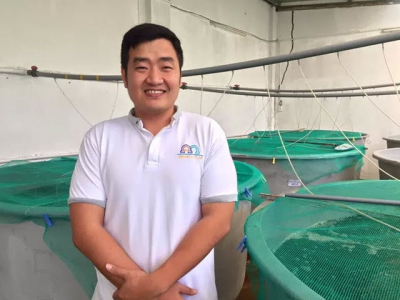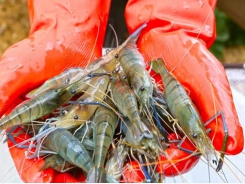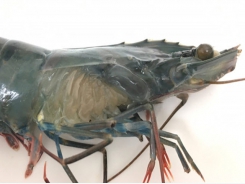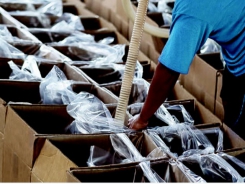The Loc star of shrimp health

Dr Loc Tran, founder of ShrimpVet and one of the key researchers behind the discovery of the causes of EMS in shrimp, explains how he was prepared to risk the wrath of his mother to establish the Vietnam aquaculture industry’s first private diagnostic laboratory.
Dr Loc Tran, the founder of ShrimpVet
“I made my first lab after knocking down my mother’s kitchen. She was mad, she didn’t understand what I was trying to do, and it meant she had nowhere to cook,” Dr Loc chuckles
Loc, who was raised in Ho Chi Min City, but spent some of his most formative years studying at the University of Arizona’s College of Agriculture and Life Sciences, has an enthusiasm for aquaculture that is both immediately apparent and rooted in his youth.
“I grew up in the early 80s, when Vietnam was still quite isolated and suffering economically due to the sanctions. There was only nature and fish and paddy fields, and I was in love with aquatic species – fish and shrimp were like my pets,” he recalls.
“It also helped that my dad was a professor of aquaculture at the university and although most of the fish available was wild-caught, they had a hatchery for carp and tilapia and I was aware that aquaculture was an important part of the economy, supporting millions of households, although only in the last 20-25 years did professional, rather than subsistence, aquaculture, emerge,” he adds.
After completing his undergraduate degree in Vietnam, he moved to Arizona – a period that was crowned by a research breakthrough with a global impact: as part of the team in Dr Donald Lightner’s lab that discovered the causes of early mortality syndrome (EMS) in shrimp. Loc’s research established how and why this was taking place – via a toxic strain of the Vibrio bacteria that infects the shrimps’ hepatopancreas, making them vulnerable to a secondary infection of acute hepatopancreas necrosis disease.
“It seems like a long time ago now,” he says. “At that time EMS was a worldwide epidemic, costing the shrimp industry in Vietnam and Thailand alone over $1 billion a year. We had been really stuck and we’d tested so many theories.”

Loc now oversees more than 100 employees, a central office, two labs, a commercial-scale hatchery and a shrimp farm in and around Ho Chi Minh City
Alleviating EMS was particularly important for Loc, given the impact it was having on his own country, and during his PhD studies he returned to Vietnam in 2012 to see if he could get any clues about the disease from the field.
“In 2009-10 there was almost an oversupply of shrimp, especially in Vietnam and Thailand. But then EMS knocked out the industry in Vietnam, Thailand and China one by one. Thousands of households lost their crops and couldn’t make a living. I visited Vietnam with both my PhD advisors, Dr Lightner and Dr Kevin Fitzsimmons, and it was so sad to see thousands of abandoned shrimp ponds,” he explains.
We began to suspect EMS was a bacterial disease and came up with possible solutions such as the polyculture of shrimp and tilapia as a means to balance to microbiota in the ponds – it was known as a way to minimise the impact of bacterial diseases such as Vibriosis
The academics began to wonder if the new disease was in fact bacterial and decided to trial an alternative farming method – the results of which suggested their theory might be correct.
“We Arizona folks began to suspect EMS was a bacterial disease and came up with possible solutions such as the polyculture of shrimp and tilapia as a means to balance to microbiota in the ponds – it was known as a way to minimise the impact of bacterial diseases such as Vibriosis in earthen ponds,” he explains.
“Although we weren’t sure if EMS was bacterial we couldn’t ignore the theory and we could see the results. We helped introduce polyculture in 2012 and by 2014, when around 50 percent of the country’s shrimp farmers were practicing polyculture, it was helping the country’s shrimp industry grow by 15 percent a year,” he adds.
On his return to Arizona he was able to bear the theory out in his lab work – despite having helped to resuscitate the Southeast Asian shrimp industry, he still had to finish off his thesis.
“It was important for me personally too, as I’d put all my future in my PhD thesis, so it was particularly rewarding when we made the breakthrough,” he explains.
Return to Vietnam
Not content to rest on his laurels, after being awarded his doctorate Loc returned to Vietnam with another ambitious plan up his sleeve – to start up his own company. He did this despite possessing no funds – hence the use of his mother’s kitchen – and very little business experience.
“The shrimp industry in Vietnam was so important but we had no private shrimp disease labs – I felt someone needed to take the initiative and solve this problem,” he explains.
Loc drew on the experiences of his mentors in Arizona.
“I was inspired by Dr Lightner and Dr Fitzsimmons – Dr Lightner started up his own shrimp pathology lab in his early 30s while working as a professor, and I was in a similar position at a similar age – still young enough to give it a shot,” he explains.
However, despite his conviction, Loc found it hard to persuade the Vietnamese that such a venture could be commercially successful.
“Very few people believed that supporting the whole shrimp farming community would be beneficial to their own business,” he explains.
However, Loc finally managed to convince Minh Phu Seafood, a local shrimp processor, of the value of his goal and they invested enough to allow him to kit the former kitchen out with the histopathology, PCR and microbiology equipment he needed to get started, then build a separate challenge facility.
My lab is full of crazy ideas – it’s all about new ways of looking at things, things that may be upside-down compared to what is written in the textbooks. This makes it more difficult to work with experienced people.
And once he was established the growth of his company – ShrimpVet (Minh Phu Aquamekong Co ltd) – has been meteoric and he now oversees more than 100 employees, a central office, two labs, a commercial-scale hatchery, and a shrimp farm in and around Ho Chi Minh City.
“I started with three people, then recruited seven the next year, then 20 the following year and we now have over 100 people – about 40 in R&D and diagnostics, 30-40 in hatchery technology and 15 focusing on farming techniques,” he explains.
While he mainly looks to recruit talented graduates, he is drawn to those with less conventional outlooks and approaches – the sort of blue sky thinking that enabled him to make his own breakthrough with EMS.
“My lab is full of crazy ideas – it’s all about new ways of looking at things, things that may be upside-down compared to what is written in the textbooks. This makes it more difficult to work with experienced people. So I find it best to recruit young graduates and then brainwash them,” he chuckles.
Loc has also found that Vietnamese shrimp producers have been impressively receptive to new ways of thinking and farming, and have taught him a thing or two.
“Whenever I work with a farmer in Vietnam I learn something from them – they are always open to adopting new techniques very quickly and are full of innovation and ideas, as farming is a means of survival for them. However, they don’t always have the science to support innovation,” he reflects.
Vietnamese fortunes
ShrimpVet’s rise has coincided with a dramatic increase in shrimp production in Vietnam and Loc points out that the country’s annual shrimp production has risen by 10-15 per cent a year over the last three years, reaching 650,000-700,000 tonnes in 2017. Although the polyculture system he helped to introduce may have had a hand in this increase, he points to the huge improvements in a range of farming practices that have occurred.
“In the past 4-5 years there have been so many innovations,” he reflects. “For example, in 2011, 99 percent of Vietnam’s shrimp were produced in simple earthen ponds, now the number of farmers using plastic-lined ponds with shading, bottom aeration systems, shrimp toilets, probiotics and automated systems is growing very rapidly. It’s like the sector has been transformed from a horse to a Ferrari.”
This has, according to Loc, hugely boosted productivity, which he notes has increased from 300 kg of shrimp per hectare in extensive systems to 7-10 tonnes per hectare, meaning that many SMEs that were producing 50-100 tonnes of shrimp per year in their entire farm are now producing 50-100 tonnes per hectare.
He also cites the improvements in shrimp genetics as being essential for this growth.
“Shrimp are now growing 2.5 times quicker and therefore the culture cycle is being shortened, with shrimp reaching 30-35 grams in 90-110 days now, allowing a greater volume to be produced in any system in any year,” he explains.
Given his enthusiasm for genetics it’s no surprise that he collaborates with broodstock companies to improve the genetic lines of his post-larvae (PL). And he’d like to ramp this up.
“I’d love to collaborate more closely to improve traits such as growth rates and disease-resistance,” he confesses. “And would, ultimately, like to be vertically integrated so we can control everything from genetics, to disease control, to farming protocol.”
As well as veterinary services Loc has also branched out into shrimp production – supplying both specific pathogen-free (SPF) PL and market-sized shrimp.
“We have the capacity to produce 1.5 billion SPF PL a year,” he says, “but are averaging about 50-70 million a month.”
And his customers, who range in size from small-scale producers to large corporations, are all given free consultancy as part of the deal.
“He now sells post-larvae and diagnostic services to customers, which was pretty revolutionary compared to what others were doing in the region, and now everyone is beating a path to his door,” Dr Fitzsimmons, his former mentor, explains.
“I’m proud of a student doing so well and helping the industry – I want him and the people buying his services to succeed,” he adds.
Future plans
Despite its name, ShrimpVet works with a variety of species, including tilapia, pangasius and barramundi, with a focus on nutrition and health. And, despite its roots in Vietnam, Loc is looking to work more widely in other countries too.
“We’re considering establishing a diagnostic lab, research centre and hatchery in Myanmar,” he explains, “and also plan to work more in Latin America, especially Ecuador, where we will be establishing a presence after the GOAL conference in September.”
Looking ahead, Loc believes that disease might not be the biggest threat facing the shrimp industry.
“We now know how to solve all the recent disease challenges, such as EMS, EHP and white faeces syndrome,” he explains. “So food safety is perhaps a bigger challenge – we need to stop the high levels of shrimp shipments currently being rejected due to food safety concerns. We have been working very hard to improve this – there is no reason for farmers to use antibiotics and they increase production costs.”
Through ShrimpVet he is already tackling this challenge.
As Dr Fitzsimmons explains: “Providing certified healthy and disease-free PL, as well as veterinary care and advice through production and harvest, improves both health and food safety from beginning to end – the farmer increases efficiency by reducing mortality and the use of antibiotics, while consumers in both Vietnam and internationally benefit from higher quality shrimp.”
And as for Loc's mother?
"She now has a brand new kitchen," Loc chuckles, "and is happy to collect the rent for her old one. We might have lots of new sites now but it's still my office!"
Related news
Tools

Phối trộn thức ăn chăn nuôi

Pha dung dịch thủy canh

Định mức cho tôm ăn

Phối trộn phân bón NPK

Xác định tỷ lệ tôm sống

Chuyển đổi đơn vị phân bón

Xác định công suất sục khí

Chuyển đổi đơn vị tôm

Tính diện tích nhà kính

Tính thể tích ao




 Rising use of automatic feeders in shrimp ponds…
Rising use of automatic feeders in shrimp ponds…  A plant-based solution to shrimp health
A plant-based solution to shrimp health